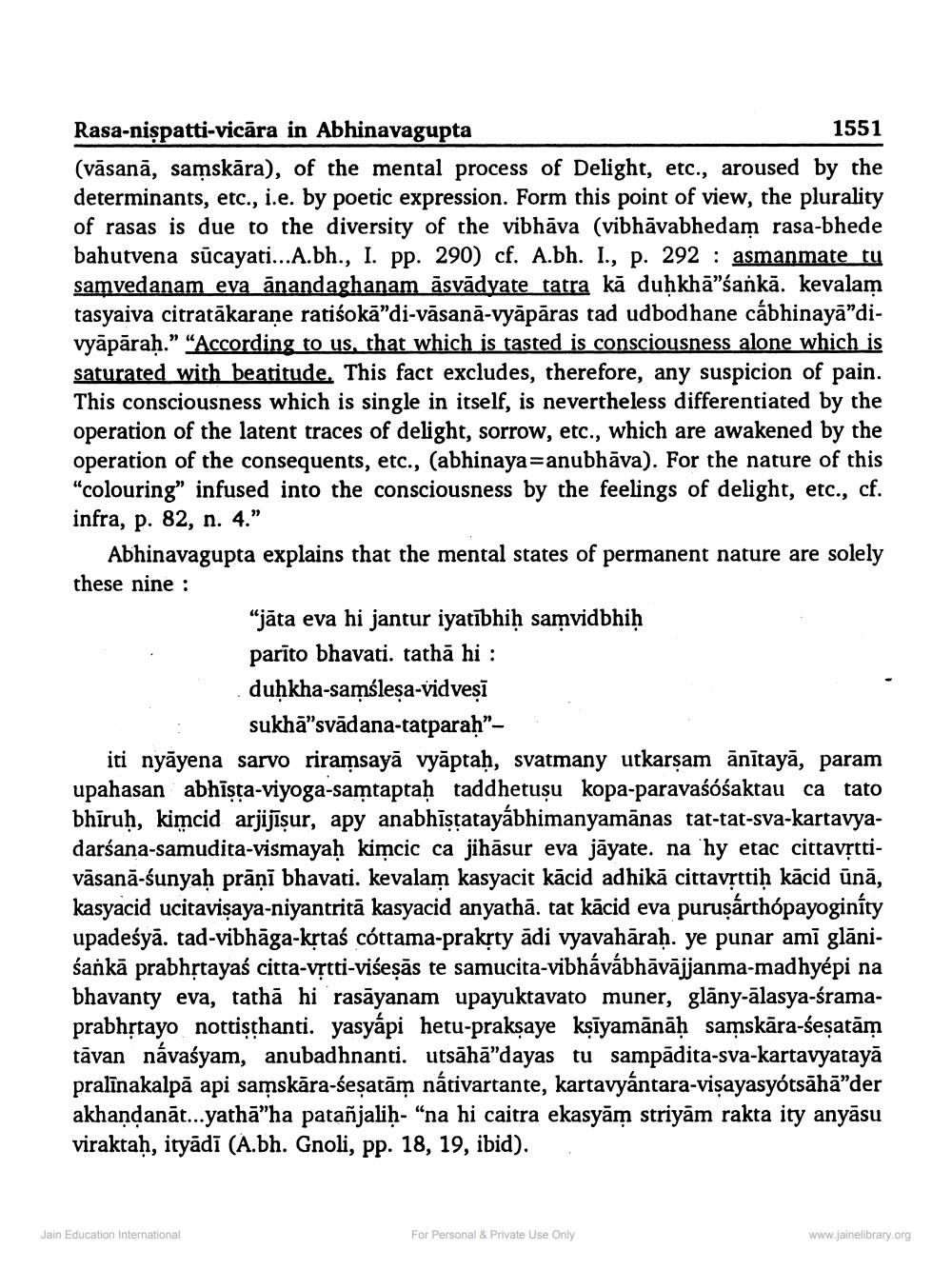________________
Rasa-niṣpatti-vicara in Abhinavagupta
1551
(vāsanā, samskāra), of the mental process of Delight, etc., aroused by the determinants, etc., i.e. by poetic expression. Form this point of view, the plurality of rasas is due to the diversity of the vibhāva (vibhāvabhedam rasa-bhede bahutvena sūcayati...A.bh., I. pp. 290) cf. A.bh. I., p. 292: asmanmate tu samvedanam eva ānandaghanam āsvādyate tatra kā duḥkhā"śankā. kevalam tasyaiva citratakarane ratiśokā"di-vāsanā-vyāpāras tad udbodhane cábhinaya"divyāpāraḥ." "According to us, that which is tasted is consciousness alone which is saturated with beatitude. This fact excludes, therefore, any suspicion of pain. This consciousness which is single in itself, is nevertheless differentiated by the operation of the latent traces of delight, sorrow, etc., which are awakened by the operation of the consequents, etc., (abhinaya anubhava). For the nature of this "colouring" infused into the consciousness by the feelings of delight, etc., cf. infra, p. 82, n. 4."
Abhinavagupta explains that the mental states of permanent nature are solely these nine:
"jāta eva hi jantur iyatībhiḥ samvidbhiḥ parīto bhavati. tathā hi :
Jain Education International
duḥkha-samśleṣa-vidveṣi
sukhā"svādana-tatparaḥ"
iti nyāyena sarvo riramsayā vyāptaḥ, svatmany utkarṣam ānītayā, param upahasan abhista-viyoga-samtaptaḥ taddhetuşu kopa-paravaśóśaktau ca tato bhīruḥ, kimcid arjijiṣur, apy anabhīṣṭatayábhimanyamānas tat-tat-sva-kartavyadarśana-samudita-vismayaḥ kimcic ca jihāsur eva jāyate. na hy etac cittavṛttivāsanā-śunyaḥ prāṇī bhavati. kevalam kasyacit kācid adhikā cittavṛttiḥ kācid ūnā, kasyacid ucitaviṣaya-niyantrita kasyacid anyathā. tat kacid eva puruṣárthópayoginity upadeśyā. tad-vibhāga-kṛtaś cóttama-prakṛty ādi vyavahāraḥ. ye punar ami glāniśankā prabhṛtayaś citta-vṛtti-viseṣās te samucita-vibhávábhāvājjanma-madhyépi na bhavanty eva, tathā hi rasāyanam upayuktavato muner, glāny-ālasya-śramaprabhṛtayo nottisthanti. yasyapi hetu-prakṣaye kṣīyamānāḥ samskāra-seṣatām tavan návaśyam, anubadhnanti. utsāhā"dayas tu sampādita-sva-kartavyatayā pralinakalpā api samskāra-seṣatām nátivartante, kartavyántara-viṣayasyótsāhā❞der akhaṇḍanāt...yathā"ha patanjaliḥ- "na hi caitra ekasyām striyām rakta ity anyāsu viraktaḥ, ityādī (A.bh. Gnoli, pp. 18, 19, ibid).
For Personal & Private Use Only
www.jainelibrary.org




